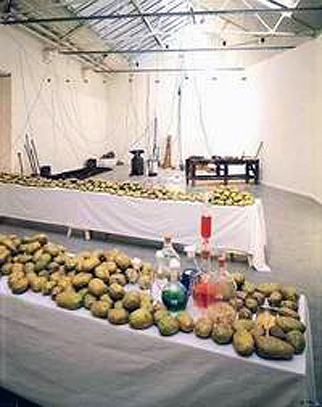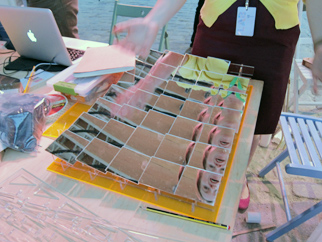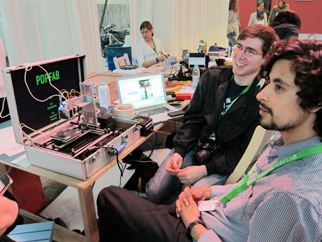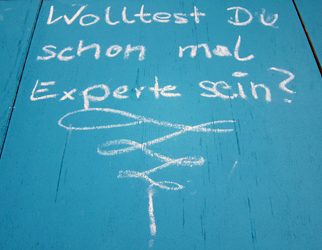
Victor Grippo, "Analogía I", 1977 (2. Fasung). Foto: M.A. Gómez.





BMW-Guggenheim Lab, 15. - 29 Juli 2012, Pfefferberg, Berlin. Fotos: Stella Veciana.
|
"Low-tech" versus "high-tech" cooperation: the politically charged potatoes of Víctor Grippo and the controversial BMW Guggenheim Lab Berlin.
Stella Veciana
In the seventies, the Argentine chemist and artist Victor Grippo (* 1936, † 2002) developed his "analogies", a number of low-tech experiments involving potatoes. In his work, Grippo transformed potatoes into rudimentary batteries - connected to electrodes, they can transfer small amounts of electricity. His visionary contribution to the energy debate and to alternative social models are still relevant today.
In the installation "Analogía I", potatoes are prepared for a technical experiment on a long table. Wires connect three to five potatoes with each other, and these smaller groups are then joined together to form larger groups. The last two wires are connected to a voltmeter that measures the total energy of the potatoes, once the device is turned on by a visitor. Over time, the potatoes lose their "vegetative energy", and the measured power decreases. The voltmeter makes it possible to quantify and to scientifically analyse the duration and stability of the plant-energy process.
Grippo's concern here, however, is different from that of a quantifying scientist. With the choice of potatoes, he questions the underlying social, political, historical, scientific and technological contexts of his energy-related experiments. More fruits and vegetables also have this property, which other artists have used to refer to alternative models of society - as, for example, Joseph Beuys, who took lemons for his "Capri Battery" in 1985.
In the "analogies", according to Grippo, the potato is not only a symbol of the daily food of farmers, but also of the colonial and post-colonial history of a comestible, which was exported to Spain around 1534 from the region which is now Chile and Peru. In return, pesticides and patented seeds from the Western biotech industry are today imported back into the emerging markets, where they are unaffordable for many farmers, leading to their ruin.
The "high-tech" research of the industrial countries try to solve the world hunger problem with genetic technologies, even though the technological risks are unclear and their political framing is not oriented towards sustainability. Here the contradictory role of the industrialized countries becomes evident. On the one hand they provide development aid, and on the other hand they try to maintain their position of economic power: a continuous balancing between cooperation and competition. What Elsa Flores Ballesteros calls Grippo's "critical regionalism"[1] could be seen as a contrast. His Potato installations would refer to "low-tech systems" working with "poor materials" and aspiring to regional self-sufficiency.
Peter Weibel speaks in this context of a contemporary aesthetic that de-colonizes: "The concern for the third world is no longer articulated through the instruments of the first world, but is formulated and expressed through the means of the third world. This constitutes a “contract between an aesthetic and social solidarity".[2] Grippo's "analogies" can be understood not only as an institutional critique of the Western scientific system and its close involvement with industry, but also as a plea to science to take social responsibility. This implicit invitation to experience social solidarity has received quite a positive feedback from within the artistic community.
In other contexts, however, the presentation of such low-tech experiments can become problematic, as at the citizen science laboratory of the “BMW Guggenheim Lab”. In the shadow of a mobile structure made of carbon fibre, different "low-tech systems" of students and low-tech companies from the USA were shown. Students of the MIT Media Lab from Boston presented their playful Makeymakey project - piano keys made of banana. But also more serious concerns were resolved with low-tech participatory approaches, such as the medi-kit of "LDTC + Labs. Democratized Medical Technologies from Cambridge / MA. A modular mirror design is designed to bring water to boil with only the help of solar radiation. This allows, for example, doctors in desert areas without electricity to disinfect their scalpels. The health kits are being developed together with the inhabitants, consist of simply replaceable modular components, and are made from locally available materials.
Grippo would probably have appreciated all these projects, but they were very critically received by the audience within the context of the BMW Guggenheim Lab. "A university on the street, would this work?" is written on one of the tables prepared to encourage dialogue. On another table, the question "Did you ever want be an expert?" can be read. The question seems to show a well-intentioned will for participation, but may come across as rather arrogant, and therefore creates an immediate opposition. The project conceived as a “think tank, community centre and public gathering space”, wanted to bring together experts and residents to discuss “the future of cities today.” However, the residents were not involved in the early stages of the development process, and an initiative against the lab, the "bmwlabverhindern", was created. Although the massive protests from the anti-Mediaspree movement did not manage to stop the project entirely, the lab moved from its originally planned venue in Kreuzberg (on the brownfield Schlesische Street / Cuvrystreet) to Pfefferberg in Prenzlauer Berg.
The criticism assumed that "BMW wanted to buy into the public space", and that the sole purpose of the project was as a prestige advertisement against competing car manufacturers such as Audi, and for clearing up BMW’s Nazi past. Thought provoking is also the fact that all the participants presenting "low-tech systems" and also the project staff themselves were flown in from America, at least according to statements made by staff members who worked there that day. The local involvement in the project probably failed already on the staff level. This gives cause for concern. What about the local connection to international cooperation projects working on the global future? How is the research cooperation with developing countries organized? International research cooperation usually follow a western approach. This is specifically the case with trans-disciplinary research, i.e. the research that involves local residents or otherwise affected locals. Finding ways of how international research cooperation between industrialized, emerging and developing countries should function, as in the case of the development of "low-tech models," require new conceptual as well as infrastructural facilities and specially adapted subsidies.
Grippo's experiments from the seventies are simple and modest. Today they are taught in every elementary school. But the fact that these "low-tech systems" are not taught in a socio-ethical context has consequences. Their socially innovative potential to solve problems for future generations remains untapped. It is unlikely that city locals would be against a "University on the streets" or a public debate about the future of the city, but not under the auspices of large companies that fail to involve all the stakeholders. To take social responsibility means, especially in this context, to discuss the research questions for alternative social models with all involved parties, in order to develop "low-tech models" and to integrate them investing public research funding in a socially just way.
↑ 1. Elsa Flores Ballesteros. "Ideological Concept Art and Regionalism. Victor Grippo some tendencies in his poetry.“ In: Inklusion/Exclusión. Versuch einer neuen Kartographie de Kunst im Zeitalter von Postkolonialismus und globaler Migration. Exhibition Catalogue. Steirischer Herbst '96. Cologne : DuMont, 1997, p. 213.
↑ 2. Peter Weibel, „Art as Open Practice“. In: Offene Handlungsfelder. 48th Venice Biennale, Exhibition Catalogue, Cologne : DuMont, 1999, p. 10.
|